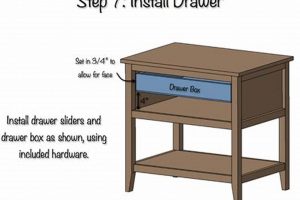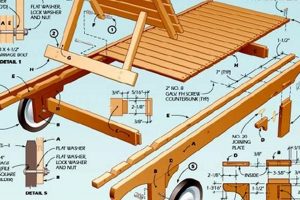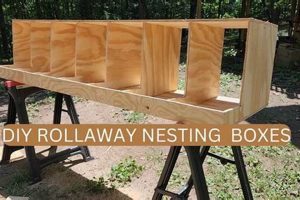The concept involves instructions and blueprints that guide individuals in the self-construction of an outdoor play structure featuring swings. An example would be a detailed document outlining the necessary materials, measurements, and assembly steps to build a wooden frame supporting two swings and a glider.
Undertaking this type of project offers several advantages. It can lead to significant cost savings compared to purchasing a pre-assembled unit. Furthermore, it allows for customization to fit specific yard dimensions and preferences. Historically, this approach reflects a tradition of resourcefulness and self-sufficiency in creating recreational equipment.
The subsequent sections will delve into crucial aspects such as selecting appropriate materials, understanding structural considerations, and ensuring adherence to safety guidelines throughout the construction process.
Construction Guidance
The following points offer focused advice to assist in the successful and safe execution of the build.
Tip 1: Material Selection: Prioritize pressure-treated lumber for structural components to resist decay and insect infestation. Opt for durable, weather-resistant materials for seats and chains to ensure longevity. Example: Use ACQ-treated lumber for posts and polyethylene for swing seats.
Tip 2: Accurate Measurements: Adhere strictly to specified dimensions within the construction documentation. Inaccurate cuts or misaligned joinery can compromise structural integrity and safety. Example: Verify diagonal measurements of the frame to ensure it is square before securing connections.
Tip 3: Secure Fasteners: Employ galvanized or stainless steel hardware designed for outdoor use. Ensure all bolts, screws, and connectors are properly tightened and inspected regularly. Example: Use lag bolts with washers to attach the swing hangers to the support beam.
Tip 4: Ground Anchoring: Secure the structure firmly to the ground to prevent tipping or movement during use. Use ground anchors or concrete footings, following the guidelines within the selected construction documentation. Example: Install ground anchors at each post location, extending below the frost line.
Tip 5: Regular Inspections: Conduct routine inspections of all components for wear, damage, or loosening. Address any issues promptly to maintain safety and prevent potential accidents. Example: Check for cracks in the wood, rust on metal parts, and wear on swing chains.
Tip 6: Safety Surfacing: Install impact-absorbing surfacing material beneath and around the play structure to mitigate the risk of injury from falls. Consider engineered wood fiber, rubber mulch, or sand. Example: Extend a 6-foot safety zone around the perimeter, filled with appropriate surfacing material.
Following these guidelines helps ensure structural soundness and promotes user safety. Attention to detail is paramount.
The succeeding segment will cover the final steps of the construction and introduce strategies for ongoing maintenance.
1. Safety Regulations
Adherence to established safety regulations is paramount when engaging in self-directed construction. These regulations serve as a foundation for ensuring a safe play environment and mitigating potential hazards inherent in elevated structures and moving components. Ignoring these guidelines can lead to serious injuries.
- Compliance with Industry Standards
Many jurisdictions adopt or reference industry standards developed by organizations such as ASTM International. These standards outline specific requirements for the design, construction, and testing of play structures. Adhering to these standards ensures that the structure meets minimum safety thresholds for stability, impact attenuation, and entrapment prevention.
- Fall Height and Surfacing Requirements
Regulations often specify maximum fall heights for play equipment and dictate the type and depth of impact-absorbing surfacing material required beneath and around the structure. Proper surfacing is crucial in minimizing the severity of injuries resulting from falls. Failure to comply with surfacing requirements can significantly increase the risk of head injuries and fractures.
- Entrapment Hazards
Safety regulations address potential entrapment hazards, such as openings that could trap a child’s head or limbs. Specific dimensional requirements are often stipulated to minimize these risks. Careful attention to these details during the design and construction phases is essential to prevent serious injuries, including strangulation.
- Hardware and Fastener Specifications
Regulations may also specify the type and grade of hardware and fasteners used in construction. Corrosion-resistant materials and secure connections are critical for maintaining structural integrity and preventing component failure. The use of substandard materials can compromise the stability of the entire structure and lead to catastrophic collapses.
The incorporation of these regulatory considerations into the planning and execution phases is not merely a formality but a fundamental responsibility. Diligence in understanding and implementing these standards directly contributes to the safety and well-being of children using the play structure.
2. Material Durability
Material durability exerts a significant influence on the long-term viability and safety of any play structure realized through self-directed construction. The selection of resilient materials directly impacts the structure’s ability to withstand environmental stressors, usage demands, and the passage of time. For instance, untreated wood is susceptible to rot, insect infestation, and structural weakening, leading to premature failure and potential hazards. In contrast, employing pressure-treated lumber, naturally decay-resistant wood species, or durable composite materials mitigates these risks, extending the lifespan of the swing set and reducing the frequency of repairs or replacements. The initial investment in more durable materials often results in significant cost savings over the lifespan of the structure.
The correlation between material quality and safety is paramount. Substandard materials may exhibit reduced load-bearing capacity, increased susceptibility to fractures or splintering, and compromised fastener retention. A swing beam constructed from low-grade wood, for example, may develop cracks under stress, potentially leading to a collapse. Similarly, using inexpensive, non-galvanized hardware can result in corrosion and weakening of connections. Implementing plans specifying appropriate, high-quality materials minimizes these risks, contributing to a safer play environment. Further, understanding the specific properties of different materials, such as the tensile strength of steel versus the flexibility of certain plastics, enables informed decision-making during the selection process.
In summary, prioritizing material durability within the project blueprint is not merely an aesthetic consideration, but a critical factor influencing safety, longevity, and overall cost-effectiveness. A thorough understanding of material properties and their suitability for outdoor play structures is essential for ensuring a durable and reliable final product. Neglecting this aspect can lead to premature failure, increased maintenance costs, and, most importantly, compromised safety. Therefore, any comprehensive instructions must clearly specify appropriate materials and construction techniques that maximize durability.
3. Structural Integrity
Structural integrity, in the context of self-constructed play equipment, represents the ability of the assembled structure to withstand applied loads and environmental forces without catastrophic failure. Construction blueprints must prioritize this aspect, as compromised structural integrity directly translates to an increased risk of collapse and subsequent injury. For instance, a design lacking adequate bracing or utilizing undersized support beams may fail under the combined weight of multiple users and dynamic swinging forces. Proper load calculations, detailed material specifications, and precise assembly instructions within the blueprints are fundamental to ensuring the structural integrity of the completed playset.
The importance of robust joinery cannot be overstated. Weak or improperly executed connections between structural members represent common points of failure. Blueprints should clearly specify the appropriate type and size of fasteners (e.g., bolts, screws, lag bolts) and detail proper installation techniques. An example is the connection between the swing beam and the support posts; a poorly executed joint at this location can lead to gradual loosening and eventual collapse. Regular inspection of these connections, as outlined in maintenance documentation accompanying the instructions, is also essential for identifying and addressing potential problems before they escalate into safety hazards. Different assembly methods affect the capacity.
In summation, structural integrity forms the bedrock of safe and functional self-built play equipment. The blueprints serve as the primary vehicle for conveying critical design and construction information necessary to achieve this integrity. Deficiencies in this regard can lead to serious consequences, underscoring the need for meticulous adherence to sound engineering principles and rigorous quality control throughout the construction process. The success of the project is directly dependent on the emphasis placed on structural soundness.
4. Design Customization
Design customization represents a significant facet of the appeal associated with self-directed construction using readily available instructions. The ability to modify pre-existing blueprints or to create entirely novel designs provides an opportunity to tailor the play structure to specific spatial constraints, aesthetic preferences, and functional requirements. This aspect contrasts sharply with the limitations inherent in purchasing pre-fabricated units, where customization options are often restricted. The effect of this control extends to the selection of materials, colors, and features, enabling the creation of a play environment uniquely suited to the intended users and the surrounding environment.
The importance of design customization is particularly evident in situations where standard configurations are unsuitable. Examples include yards with irregular dimensions, uneven terrain, or the presence of existing landscaping features that must be accommodated. Furthermore, customization allows for the incorporation of specific play elements, such as climbing walls, slides, or sandboxes, catering to the developmental needs and interests of children. It also presents the opportunity to integrate accessibility features, ensuring that the structure can be enjoyed by children with disabilities. This proactive approach is significant to the project.
However, design customization also introduces complexities and responsibilities. Alterations to structural components or dimensions must be undertaken with a thorough understanding of engineering principles and safety regulations. Uninformed modifications can compromise structural integrity and increase the risk of accidents. Therefore, while customization offers considerable benefits, it necessitates a careful balance between individual preferences and adherence to established safety standards. The process provides an understanding with the final product.
5. Cost Efficiency
Undertaking a “swing set plans diy” project often stems from a desire for cost efficiency compared to purchasing a pre-assembled unit. The primary driver of this cost reduction lies in the elimination of manufacturing overhead, retail markups, and assembly labor charges typically incorporated into the price of commercially available swing sets. Direct procurement of raw materials, such as lumber, hardware, and swing components, allows for price comparison and negotiation, affording greater control over project expenses. Cost efficiency, therefore, becomes a central component of “swing set plans diy,” influencing material selection, design complexity, and the extent of customization undertaken.
However, realizing true cost efficiency requires careful planning and execution. Overlooking the cost of specialized tools, unforeseen material waste, or errors in construction can erode the anticipated savings. For example, selecting a more complex design with intricate joinery may necessitate the purchase of specialized power tools, offsetting the initial material cost advantage. Similarly, inaccurate measurements leading to material waste can increase overall project expenses. A real-life example involves the construction of a simple A-frame swing set using reclaimed lumber, significantly reducing material costs, versus a multi-featured set requiring precise cuts and specialized hardware, potentially negating the anticipated cost savings. Therefore, the scope and complexity of “swing set plans diy” must align with available skills and resources to achieve the desired cost efficiency.
In conclusion, the potential for cost efficiency serves as a significant motivator for pursuing “swing set plans diy.” However, realizing this potential requires a comprehensive understanding of all associated costs, careful planning, and the avoidance of unforeseen expenses. Strategic material selection, a manageable design, and proficient construction skills are paramount to achieving genuine cost savings. The success of the project, viewed from a financial perspective, hinges on the ability to balance desired features with budgetary constraints, ensuring that the final product represents a tangible value proposition.
6. Assembly Process
The assembly process constitutes a critical phase in the realization of any “swing set plans diy” project. It is the stage where the design and materials converge, demanding precision and adherence to the provided instructions to ensure structural integrity and user safety. Deficiencies in the assembly process can negate even the most well-conceived plans and meticulously selected materials.
- Interpretation of Plans
The initial step involves accurate interpretation of the blueprints or instructions included with “swing set plans diy.” This necessitates a thorough understanding of technical drawings, material lists, and step-by-step assembly procedures. Misinterpretation can lead to incorrect component placement, improper fastening, and compromised structural stability. An example is misreading the designated length of a support beam, resulting in inadequate support and potential collapse under load.
- Component Preparation
Prior to assembly, proper preparation of individual components is crucial. This may involve cutting lumber to specified dimensions, pre-drilling holes for fasteners, or applying protective coatings. Inadequate preparation can hinder the assembly process and affect the long-term durability of the structure. For instance, failure to properly seal exposed wood surfaces can accelerate decay and reduce the lifespan of the swing set.
- Fastening Techniques
The assembly process relies heavily on the proper application of fastening techniques. This encompasses the selection of appropriate fasteners (e.g., screws, bolts, lag bolts) and their correct installation. Over-tightening or under-tightening fasteners can weaken connections and compromise structural integrity. Using the wrong type of fastener, such as drywall screws in place of exterior-grade screws, will result in corrosion and failure over time.
- Quality Control Checks
Throughout the assembly process, regular quality control checks are essential. This involves verifying dimensions, ensuring proper alignment of components, and inspecting connections for tightness and stability. Failure to conduct these checks can lead to the accumulation of errors, resulting in a structurally unsound and potentially hazardous swing set. One important check involves verifying the squareness of the assembled frame before proceeding to subsequent steps.
The successful execution of “swing set plans diy” is inextricably linked to a meticulous and conscientious approach to the assembly process. Adherence to the provided instructions, careful component preparation, proper fastening techniques, and diligent quality control checks are paramount to creating a safe and durable play structure. Neglecting these aspects can undermine the entire project, negating the benefits of design customization and cost efficiency.
Frequently Asked Questions
The following addresses common inquiries concerning the self-directed construction of play structures, providing guidance on critical aspects of the process.
Question 1: What are the primary safety considerations when implementing “swing set plans diy”?
Safety considerations encompass adherence to industry standards (e.g., ASTM), appropriate fall height and surfacing materials, mitigation of entrapment hazards, and the selection of robust hardware. Compliance with these standards minimizes the risk of injury during play.
Question 2: How does material selection impact the longevity of a “swing set plans diy” structure?
The choice of materials directly influences the lifespan of the swing set. Pressure-treated lumber, weather-resistant hardware, and durable swing components are essential for resisting decay, corrosion, and wear, extending the structure’s service life.
Question 3: What role does structural integrity play in a “swing set plans diy” project?
Structural integrity is paramount, ensuring the structure can withstand applied loads without failure. Plans must incorporate appropriate load calculations, robust joinery techniques, and detailed material specifications to guarantee stability and prevent collapse.
Question 4: How much customization is advisable when utilizing “swing set plans diy”?
Customization is permissible, but alterations to the original plans must be undertaken with caution. Modifications to structural components or dimensions can compromise safety and should only be performed with a thorough understanding of engineering principles.
Question 5: What strategies can be employed to maximize cost efficiency in a “swing set plans diy” endeavor?
Cost efficiency is achieved through careful planning, strategic material selection, and proficient construction skills. Avoiding unnecessary design complexity and minimizing material waste are crucial for controlling project expenses.
Question 6: What are the critical elements of the assembly process when engaging in “swing set plans diy”?
The assembly process demands meticulous adherence to instructions, proper component preparation, accurate fastening techniques, and diligent quality control checks. Deficiencies in any of these areas can compromise the structural integrity and safety of the finished product.
The information above highlights the fundamental aspects to consider when undertaking such a project.
The following section addresses common misconceptions surrounding “swing set plans diy”.
Conclusion
This exploration of “swing set plans diy” has underscored the multifaceted nature of self-directed play structure construction. Critical elements such as safety regulations, material durability, structural integrity, design customization, cost efficiency, and assembly processes have been examined, revealing the intricate interplay between design, engineering, and practical execution. It has become clear that the success of any “swing set plans diy” endeavor hinges on a comprehensive understanding of these elements and a commitment to rigorous adherence to established safety standards.
The decision to undertake such a project demands careful consideration. While the potential for cost savings and customization is appealing, the responsibility for ensuring structural soundness and user safety rests squarely with the individual. Diligence, meticulous planning, and a commitment to quality are not optional but essential for transforming a blueprint into a safe and enduring recreational amenity. The principles outlined in this document offer a foundation for informed decision-making and responsible action.







